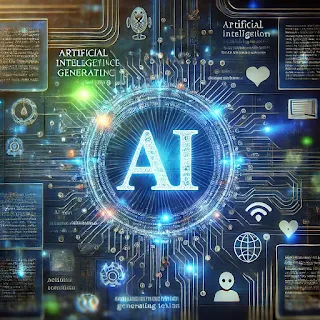AI-Generated Content: How It Works and Its Applications
- Get link
- X
- Other Apps
AI-Generated Content: How It Works and Its Applications
Introduction
Artificial Intelligence (AI) has reshaped how content is created and consumed in today's digital era. From crafting engaging blog posts to generating entire scripts, AI has emerged as a transformative tool for content creators and businesses alike. This article dives deep into the mechanisms of AI-generated content, its applications, and the challenges it poses, while offering practical insights for leveraging its potential.
Understanding AI-Generated Content
AI-generated content refers to textual, visual, or auditory material created by AI systems using machine learning algorithms. These models analyze extensive datasets to learn patterns, structures, and relationships, enabling them to generate content that closely resembles human creation.
 |
| AI generating text: A glimpse into how artificial intelligence powers modern content creation |
Key Technologies Behind AI-Generated Content
- Natural Language Processing (NLP):
Enables machines to understand, process, and generate human language by analyzing syntax, semantics, and context. - Machine Learning (ML):
ML algorithms, particularly deep learning models, learn from vast datasets to identify patterns and relationships, allowing them to create sophisticated content. - Large Language Models (LLMs):
Advanced LLMs, such as GPT models, utilize billions of parameters to generate human-like text, ensuring contextual relevance and consistency.
How AI Content Generation Works
AI content creation involves three key stages:
Training Phase:
AI models process extensive datasets to learn language patterns, grammar rules, and contextual relationships.- Datasets analyzed include books, articles, and online content.
- Models develop semantic understanding, enabling them to handle diverse topics.
Content Generation Process:
- Input: AI receives prompts or parameters outlining the required content.
- Output: Content is generated based on learned patterns and refined for coherence and relevance.
Quality Control:
Modern AI tools incorporate quality checks to:- Ensure grammatical accuracy.
- Verify factual correctness.
- Optimize content for readability and engagement.
Applications of AI-Generated Content
1. Content Marketing and SEO
AI assists marketers by:
- Generating SEO-optimized articles.
- Crafting product descriptions.
- Producing social media posts and email campaigns.
2. Creative Writing and Entertainment
AI enhances creativity through:
- Generating storylines and character descriptions.
- Writing scripts for media projects.
- Assisting poets and authors with ideation.
3. Business Communications
Businesses utilize AI to:
- Draft professional emails and reports.
- Create technical documentation and proposals.
- Automate routine communications.
4. E-Commerce Content
Retailers benefit from AI by:
- Automating product descriptions.
- Generating personalized customer communications.
- Summarizing customer reviews.

AI content generation in action: Transforming industries through intelligent applications
Benefits of AI-Generated Content
Efficiency and Scalability
- Rapid production of high-quality content.
- Cost-effective operations with reduced human effort.
Consistency and Quality
- Adherence to grammar and brand guidelines.
- SEO optimization and improved readability.
Cost-Effectiveness
- Lower costs for routine content creation.
- Scalable solutions for multilingual and multi-format content.
Challenges of AI-Generated Content
- Quality Control:
AI struggles with maintaining originality, factual accuracy, and nuanced context. - Ethical Concerns:
- Transparency in AI usage.
- Copyright issues.
- Potential biases in content.
- Technical Limitations:
- Difficulty handling complex reasoning.
- Limited creativity in niche areas.
Best Practices for Leveraging AI Content
1. Strategy Integration
- Clearly define content objectives.
- Use AI to complement, not replace, human creativity.
2. Quality Assurance
- Employ rigorous human reviews.
- Fact-check and ensure SEO compliance.
3. Ethical Compliance
- Disclose AI involvement transparently.
- Protect intellectual property rights.
Future of AI-Generated Content
The field of AI content generation is rapidly evolving. Future developments may include:
- Real-Time Content Creation: Dynamic content generation tailored to user preferences.
- Enhanced Multimedia Integration: AI-generated videos and graphics seamlessly integrated with text.
- Improved Emotional Intelligence: Understanding and incorporating user sentiment for personalized experiences.
Conclusion
AI-generated content offers unparalleled efficiency, scalability, and innovation. However, leveraging its full potential requires a balanced approach that combines AI's capabilities with human oversight. Businesses that integrate AI thoughtfully into their content strategies can achieve remarkable outcomes, fostering engagement and driving growth in the digital landscape.
By embracing the synergy between AI and human expertise, organizations can unlock new frontiers in content creation while upholding authenticity, quality, and ethical standards.
Additional Resources
- Get link
- X
- Other Apps




Comments
Post a Comment